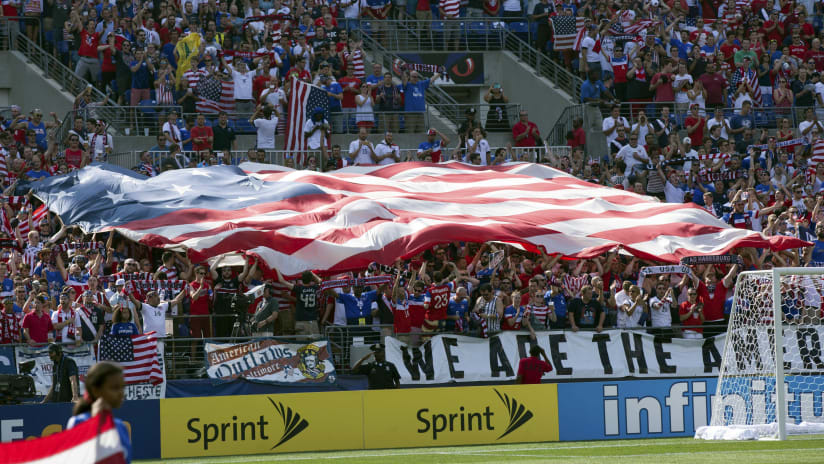We’re just a few days away from one of the biggest US-Mexico national team matches in recent memory. This Saturday, Oct. 10, the Americans are set to take on El Tri at the Rose Bowl in Pasadena, California, with a trip to the 2017 FIFA Confederations Cup on the line.
This is more than just a match-up between two heated rivals. This game promises pure madness, with 90,000-plus fans set to see their respective countries go toe-to-toe in CONCACAF’s first-ever Confederations Cup playoff.
Before we get too deep into match coverage, however, let's go through a primer on the 2015 CONCACAF Cup.
How was this match-up born? How did the US and Mexico qualify? Just how much is actually on the line?
The answers to all that – and more – are below.
WHAT EXACTLY IS THE FIFA CONFEDERATIONS CUP? WHY IS IT IMPORTANT?
One year before every World Cup, FIFA holds the Confederations Cup tournament in the World Cup host nation. All six confederations – North/Central America, South America, Europe, Asia, Africa and Oceania – send a representative to join the previous World Cup champion and host country in an eight-team competition.
The tournament, which will be held in Russia in 2017, serves as a sort of dry-run for the World Cup. Participating nations will familiarize themselves with the host country, stadiums, and travel and lodging logistics they’ll have to deal with the following year at the World Cup.
The US last participated in the Confederations Cup in South Africa in 2009, overcoming losses in their first two matches to miraculously advance out of the group stage, before beating world powerhouse Spain in the semifinals, and giving Brazil all they could handle in the title match.
The Americans credited the experience with helping them prepare for the 2010 World Cup (also held in South Africa), which saw the USMNT advance out of the group stage before falling to Ghana in the Round of 16.
Mexico qualified for the most recent edition of the tournament, in 2013, finishing behind hosts Brazil and Italy in Group A and failing to reach the knockout rounds.
Both US and Mexico will want desperately to advance to the 2017 tournament to get a leg up for the 2018 World Cup in Russia. Of course, only one will get the chance, which leads us into our next topic.
HOW DO COUNTRIES QUALIFY FOR THE CONFEDERATIONS CUP? HOW DID CONCACAF DECIDE ON THE FORMAT OF ITS CONFEDERATIONS CUP PLAYOFF?
For most confederations, selecting a Confederations Cup representative is a cut-and-dried process: Simply hold a quadrennial tournament and send the champion to the next Confederations Cup.
CONCACAF, of course, isn’t most confederations. The sport’s North and Central American governing body is one of just two confederations – along with Africa’s CAF – that holds their continental championship (that's the Gold Cup, in CONCACAF's case) once every two years as opposed to once every four years.
That creates some room for creativity in selecting a representative for the Confederations Cup. Prior to 2013, CONCACAF sent the winner of the Gold Cup held two years before the following Confederations Cup to the tournament. It was a straightforward process that saw 2011 Gold Cup winners Mexico qualify for the 2013 Confederations Cup, and 2007 Gold Cup champs US head to South Africa in 2009.
While that system didn’t require any explainer articles, it did devalue off-year Gold Cups, with regional powers like the US, Mexico and Costa Rica often sending second-choice squads to the tournament in years when a Confederations Cup berth wasn’t at stake.
That prompted CONCACAF to change its qualifying process. In April 2013, the governing body announced that its Confederations Cup representative would be decided by a one-game playoff – the CONCACAF Cup – between the winners of the two Gold Cups prior to the Confederations Cup.
If one country were to win both Gold Cups in a given cycle, they would automatically qualify for the Confederations Cup, bypassing a playoff.
HOW DID THE US AND MEXICO GET HERE?
The US began the process of advancing to the 2017 Confederations Cup on the right foot, running through the competition with a perfect record to win the 2013 Gold Cup in style. Mexico didn’t fare nearly as well, finishing second in their group before losing in the semifinals en route to a third-place finish in 2013.
The USMNT began this summer with a chance to clinch a spot in Russia 2017 with a second-straight Gold Cup title. But the Americans fell flat, watching Mexico take home the Gold Cup as they stumbled to a worst-ever fourth-place finish.
That result set up the first-ever CONCACAF Cup, which the confederation announced would be held in October at the Rose Bowl shortly after this summer’s Gold Cup tournament ended.
WHAT WILL THE ROSE BOWL LOOK LIKE ON OCT. 10?
Unlike past matches between the US and Mexico in LA – which have seen Mexican supporters vastly outnumber their American counterparts – this one should have more of a 50-50 feel in the stands.
CONCACAF is trying its best to make the Rose Bowl as neutral a site as possible. They've distributed 30 percent of the tickets to both US Soccer and the Mexican Football Federation, sold another 30 percent through a lottery to which the general public could apply, and saved the final 10 percent for sponsors and local youth teams.
If they’re able to achieve even a 60-40 split of Mexico to US fans at the game, that’ll be a huge change from the 2011 Gold Cup final at the same venue. The latter match saw the iconic stadium turn into a sea of green for Mexico’s 4-2 victory against the USMNT.













